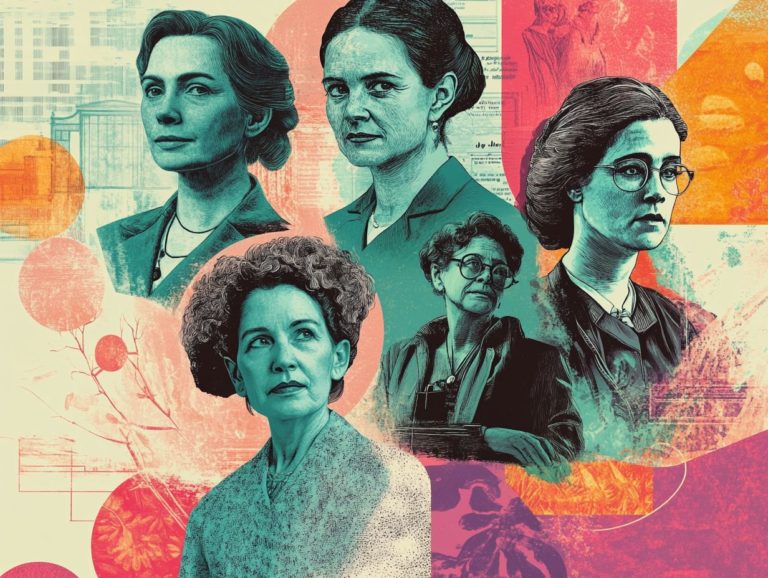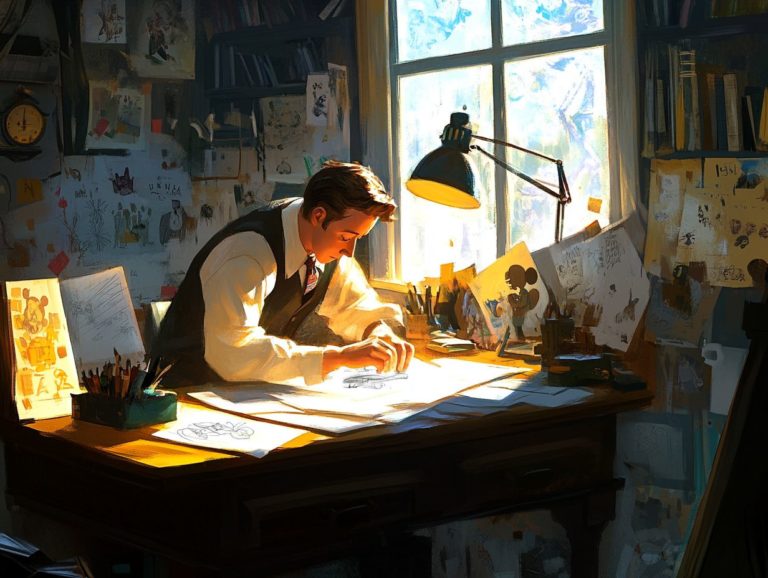The Inspiring Resilience of Frida Kahlo
Frida Kahlo’s life unfolds as a remarkable tapestry, alive with vibrant colors and profound shadows. Born into a world filled with challenges, she masterfully transformed her struggles into powerful artistic expressions that resonate deeply with many.
This exploration delves into her early influences, distinctive artistic style, and the emotional and physical traumas that shaped her identity. It highlights her incredible resilience in the face of adversity, showcasing the lasting impact she has made on future generations and the art world at large.
Join us as we uncover the inspiring story of this iconic figure!
Contents
Key Takeaways:
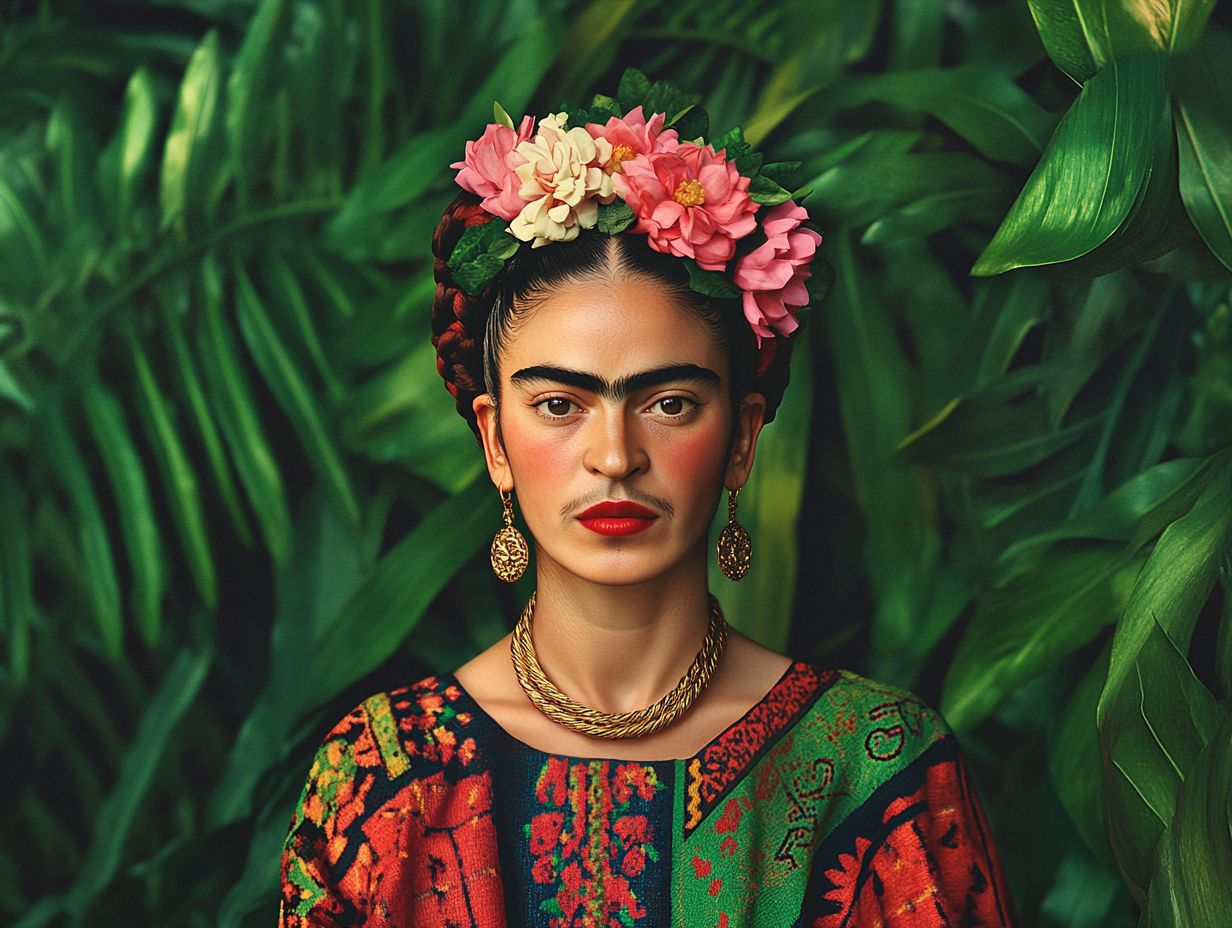
- Frida Kahlo’s early life and influences greatly shaped her artistic style and themes, reflecting her Mexican heritage and personal struggles.
- Despite facing physical and emotional trauma throughout her life, Frida’s resilience and determination allowed her to create powerful and influential works of art.
- Her legacy continues to inspire future generations, as her work is recognized and highly influential in the art world.
The Life and Art of Frida Kahlo
Frida Kahlo, born on July 6, 1907, in Coyoac n, Mexico, stands as an iconic figure in the art world. Her vibrant colors and striking self-portraits have secured her a prominent place in art history.
Her work is intricately connected to her personal experiences, shaped by emotional turmoil and physical challenges, including polio and a life-altering bus accident.
Kahlo’s art serves as a canvas for her exploration of identity and beautifully embodies elements of Mexican culture and the wider feminist art movement which highlights women’s perspectives and experiences creating a powerful narrative that continues to resonate today.
Early Life and Influences
Frida Kahlo’s early life in Coyoac n, Mexico, was woven with cultural richness and personal challenges, especially her struggle with polio, which impacted her life and art.
Growing up in a vibrant household brimming with revolutionary ideas, she was immersed in art and politics from a young age. With a father of German descent and a mother rooted in Mexican heritage, Kahlo cultivated a unique perspective that seamlessly merged these two worlds.
Her illness forged her resilience and acted as a catalyst for her creativity, urging her to delve into themes of identity and suffering. Attending the National Preparatory School for artistic education allowed her to hone her skills, while the often tumultuous dynamics within her family further ignited her passion for self-expression through painting.
This rich blend of experiences played a pivotal role in shaping the emotional depth of her work, enabling her to capture the very essence of her individuality.
Artistic Style and Themes
Frida Kahlo s artistic style captivates with its surreal imagery and vibrant colors, expertly woven into self-portraits that reveal her emotional pain and resilience.
This distinctive approach invites exploration of complex themes like identity, suffering, and the female experience, often mirroring her personal battles with health and heartbreak. Her rich symbolism, deeply embedded in Mexican culture, transforms vivid landscapes and traditional motifs into powerful narratives that resonate universally.
Through her groundbreaking artistry, she has carved a unique space within feminist art, inspiring countless women to embrace their stories while challenging societal norms. Her experiences shaped her creations, which stand as a testament to both strength and vulnerability, offering profound commentary on the human condition.
Challenges and Struggles
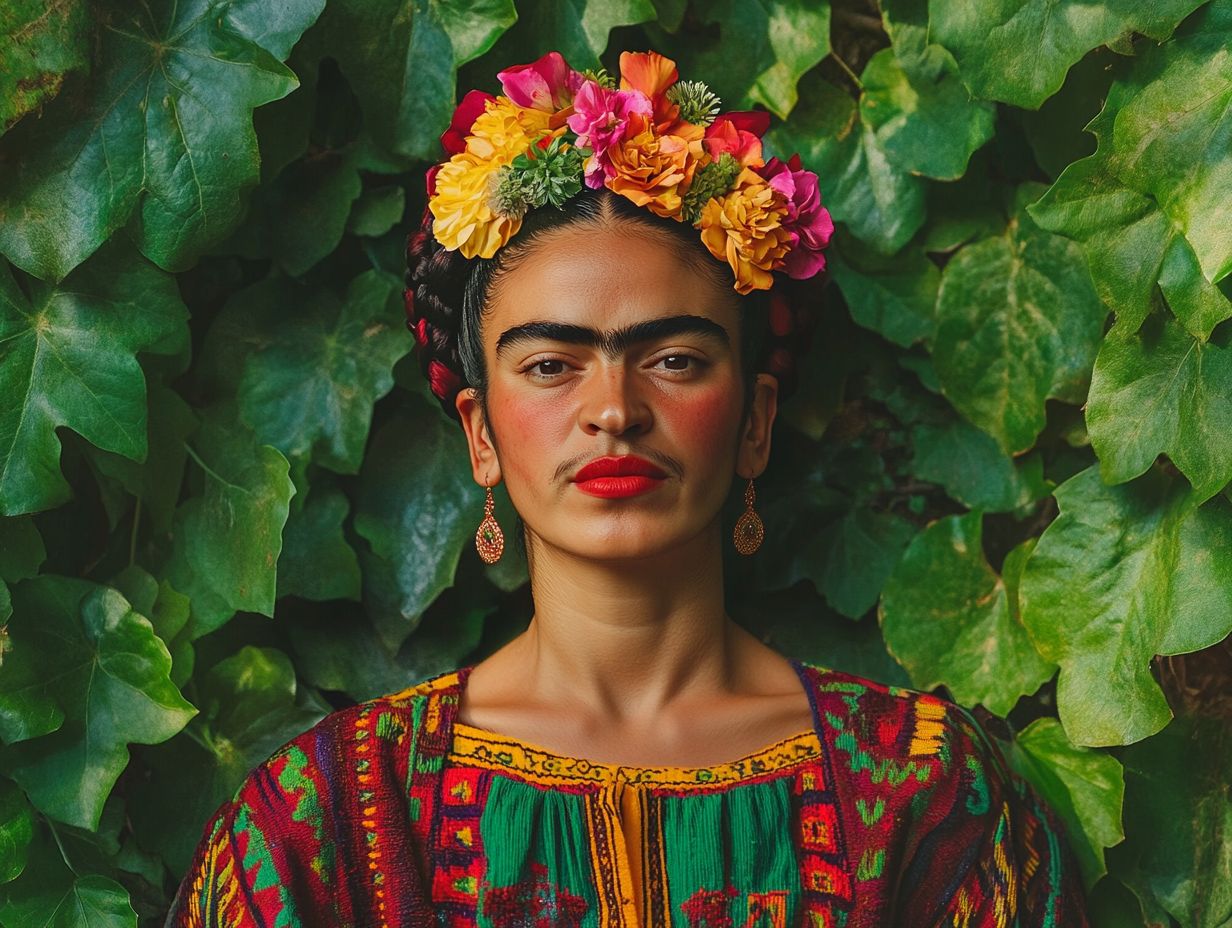
Frida Kahlo faced many challenges during her lifetime. From the debilitating effects of polio to the aftermath of a catastrophic bus accident, these experiences profoundly shaped her mental health and influenced her artistic expression in ways that resonate deeply in her work.
Physical and Emotional Trauma
The physical and emotional trauma experienced in Frida Kahlo s life story is striking, particularly stemming from her battle with polio and a life-altering bus accident.
These pivotal events shaped her existence; polio left her with a lifelong limp, while the bus accident inflicted severe spinal injuries that required numerous surgeries. Her recovery journey was long and agonizing, often plunging her into isolation and despair.
It was in these moments of vulnerability that she began to transform her pain and identity into her art.
The visceral nature of her experiences manifests in vivid imagery and bold colors, mirroring her psychological turmoil and physical suffering. In her paintings, you can explore a rich emotional landscape that offers a glimpse into the profound connection between her traumas and her extraordinary self-expression.
Resilience in the Face of Adversity
Frida Kahlo’s extraordinary resilience in the face of adversity stands as a powerful testament to strength. She masterfully transformed her emotional struggles and physical pain into art that served as therapy and embraced a profound sense of self-acceptance.
How Frida Overcame Obstacles
Frida Kahlo navigated numerous obstacles through her art, using it as a form of therapy to convey her emotional and physical pain. She ultimately transformed her struggles into a compelling narrative of resilience.
Through vivid imagery and bold colors, she crafted extraordinary self-portraits that laid bare her inner turmoil and quest for identity. A striking example is “The Two Fridas,” which beautifully illustrates her dual heritage and the emotional chasm she experienced.
Her use of symbolism, such as the broken column in “The Broken Column,” poignantly depicts her physical suffering and mental anguish. This creates a space for viewers to empathize with her struggles.
By incorporating traditional Mexican motifs and folk art techniques, she celebrated her culture while conveying universal themes of empowerment.
These artistic choices resonate profoundly, inviting you to discover strength in your own adversities.
Legacy and Impact
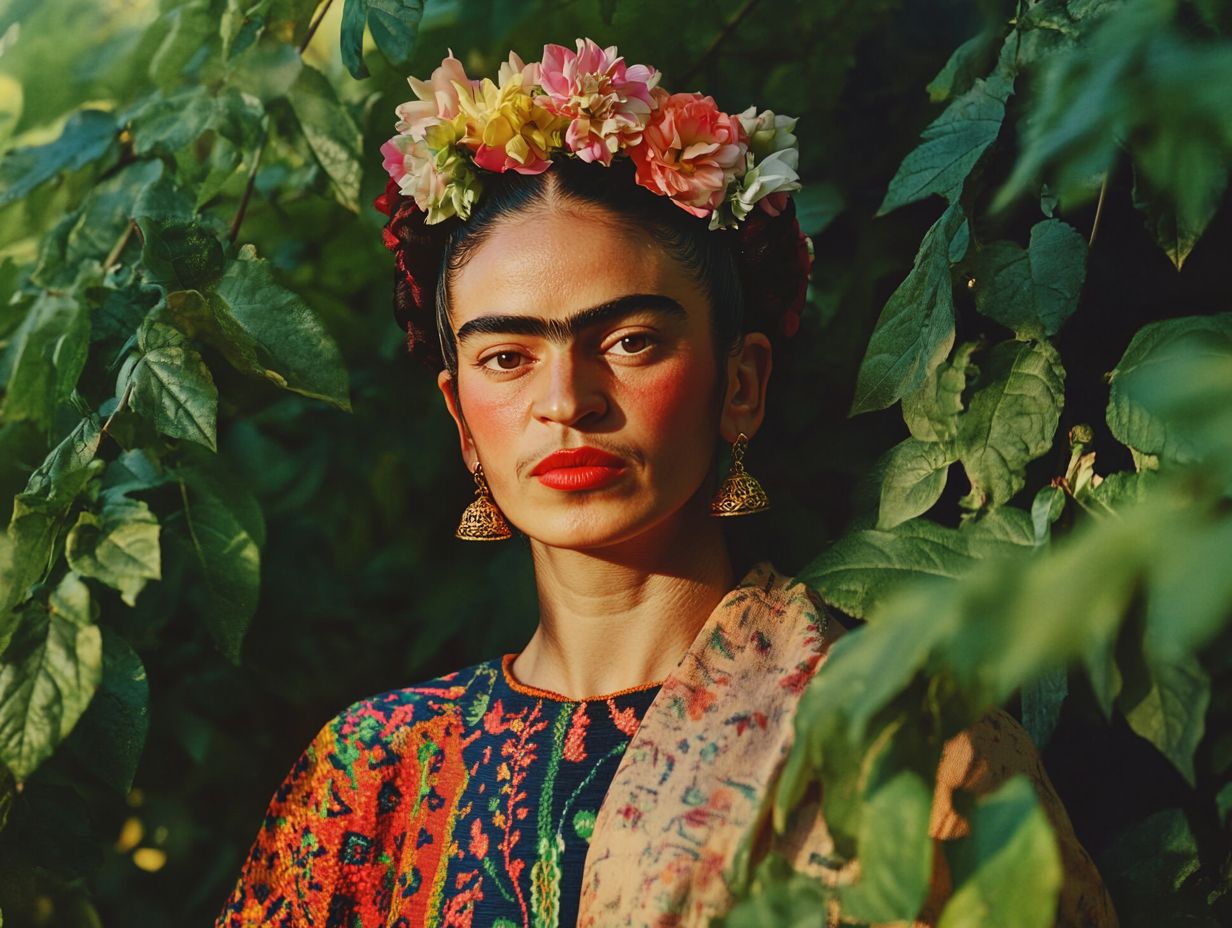
Frida Kahlo’s legacy stands as a monumental force in art history, inviting exploration of her profound impact on countless contemporary artists.
Through her fearless examination of identity, emotional turmoil, and cultural pride, she empowers women and inspires everyone who encounters her work.
Inspiring Future Generations
Frida Kahlo’s work remains a profound source of inspiration for you and countless future artists. It symbolizes empowerment and illuminates the journey of those navigating themes of identity and emotional struggle.
Discover how her influence thrives today in the contemporary art scene, where artists like Vanessa Beecroft and Ana Mendieta draw deeply from Kahlo’s exploration of personal pain and cultural roots.
Beecroft s installations reflect Kahlo’s audacious confrontations with identity, while Mendieta s creations highlight the intimate connection between body and landscape resonating with Kahlo s own fusion of self and heritage.
The exploration of resilience in today s narratives finds a compelling echo in Kahlo’s unflinching embrace of her vulnerabilities, making her an essential figure in modern feminist discourse.
Her lasting legacy actively shapes conversations about the complexities of womanhood in our ever-evolving societal landscape.
Recognition and Influence in the Art World
Frida Kahlo is a significant figure in the art world. Her unique style and deep emotions have influenced countless artists over time.
Her vibrant use of color and striking self-portraits resonate powerfully with contemporary audiences. This allows her work to transcend cultural and temporal boundaries. Over the decades, she has earned numerous awards, including retrospective exhibitions in renowned galleries that celebrate her groundbreaking contributions.
Kahlo boldly explored themes like identity, pain, and femininity. She continues to spark lively discussions today about how different parts of our identities affect our lives and self-expression. Her work inspires emerging movements, ensuring she remains a pivotal figure in modern art.
Frequently Asked Questions
Who is Frida Kahlo?

Frida Kahlo was a Mexican painter known for her powerful self-portraits and depictions of Mexican culture and society. She became a prominent figure in the art world due to her unique style and strong political views.
What inspired Frida Kahlo’s artwork?
Frida Kahlo’s artwork was largely influenced by her personal experiences. This includes her tumultuous marriage to fellow artist Diego Rivera, her struggles with chronic pain and disability, and her rich Mexican heritage and culture.
How did Frida Kahlo show resilience in her life?
Frida Kahlo faced numerous challenges and hardships in her life, such as a near-fatal bus accident and multiple health issues. Despite these obstacles, she continued to create art and advocate for social and political issues, showcasing her resilience and determination.
What are some of Frida Kahlo’s most famous paintings?
Some of Frida Kahlo’s most famous paintings include “The Two Fridas,” “Self-Portrait with Thorn Necklace and Hummingbird,” and “The Broken Column.” These works often depict her personal struggles and emotions in a raw and powerful way.
How has Frida Kahlo’s resilience influenced others?
Frida Kahlo’s resilience and strength in the face of adversity have inspired artists, activists, and individuals worldwide. She demonstrated that even in the most difficult circumstances, one can use their voice and talents to create change and make a difference.
What is Frida Kahlo’s legacy?
Frida Kahlo’s legacy extends beyond her artwork. She is recognized as a feminist icon, a symbol of Mexican identity, and a voice for marginalized communities. Her resilience, creativity, and unwavering spirit continue to inspire generations.
Explore more about Frida Kahlo and her impactful artwork to appreciate her legacy further.

